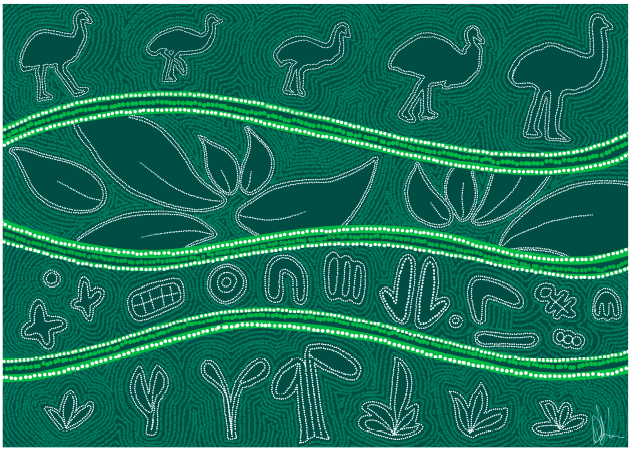What the renewable energy transition means
The transition is about Australia using cleaner energy to reduce greenhouse gas emissions that are harmful for the environment. This means moving from coal power to renewable energy like wind and solar power.
This change will create new jobs and people will learn new skills, which will help grow the economy. Australia’s goal is to achieve net zero emissions by 2050 – which means we stop adding to the problem of global warming.
A Future Made in Australia means new jobs, opportunities and inclusion by making the most of the move to renewable energy.
There are Aboriginal and Torres Strait Islander peoples around Australia working with government and businesses to ensure First Nations communities benefit from this transition now and into the future.
Back to topFirst Nations projects and peoples working in the renewable energy transition
Gladstone and Central Queensland
Artwork by Gooreng Gooreng artist Dylan Sarra

Artist's statement
This artwork is created with deep respect for the artist's country of Gooreng Gooreng in Central Queensland, as well as for all traditional owners across the land. It serves as a visual representation of the shared values and perspectives that connect First Nations cultures to the goals of Australia’s net zero economy. Each symbol chosen communicates a crucial aspect of this alignment, highlighting the importance of community, connection, cultural heritage, and resilience.
- Community and Collaboration: The depiction of a family of emus walking together signifies unity and collaboration. Emus are social creatures that exemplify strong family bonds, reflecting the essential role of community in both First Nations cultures and the transition to a net zero economy. This imagery emphasises that collective efforts are vital in achieving shared environmental goals.
- Connection to Land: The artwork features an image of leaves from a tree, symbolising the profound relationship that First Nations peoples have with the land. This connection is rooted in respect and stewardship, emphasising the need to care for the environment as we pursue sustainable practices in our energy transition. The leaves represent life, growth, and the interconnectedness of all living things.
- Cultural Knowledge and Practices: Incorporating symbols that represent traditional knowledge and storytelling underscores the importance of cultural heritage. First Nations peoples possess a wealth of ecological knowledge that can inform sustainable practices and environmental stewardship. This element of the artwork celebrates the significance of storytelling as a means of passing down wisdom and fostering a deeper understanding of our relationship with the landscape.
- Adaptation and Resilience: The image of bushfire regrowth illustrates the resilience of nature, showcasing new plant life emerging from the ashes. This powerful imagery symbolises the ability to regenerate and adapt after adversity, reflecting the strength of First Nations peoples in overcoming challenges. It also highlights the importance of recovery and sustainability in the face of climate change, reinforcing the idea that resilience is essential in our journey towards a net zero economy.
Together, this work conveys a narrative that honours First Nations cultural perspectives while advocating for a sustainable future. The artwork invites viewers to reflect on the interconnectedness of community, land, knowledge, and resilience as we collectively strive for a healthier planet.
Alana’s story – Manufacturing Production Technician at Fortescue Future Industries
Nikki’s story – Senior First Nations Engagement Advisor for Stanwell
- Nikki’s story: From resources to renewables (PDF 1.3MB)
- Nikki’s story: From resources to renewables (DOCX 34KB)
Hunter, New South Wales
Artwork by Warrimay/South Sea Islander artist Kulka Fahey

Artists’ statement
The design highlights the Awabakal, Worimi and Wonnarua countries in a sort of topography/outline style to be one of the major key focal points (relating back to the local communities and the First Nations communities that are impacted).
Meeting places with symbols of men and women sitting around them to show how the knowledge and information has been spread and the active role between the Agency and the communities.
Smaller meeting places (that are connected) representing the access to local jobs within the community.
Connection to Country and Culture portrayed through the use of symbols that relate to nature (stars, rain, wind, flowers and seeds), this can further symbolise sustainability through both jobs but more so the significant difference renewable energy within these regions can create.
Deb’s story – CEO of NSW Indigenous Chamber of Commerce
- Deb’s Story: Advocating for First Nations businesses (PDF 675 KB)
- Deb’s Story: Advocating for First Nations businesses (DOCX 33 KB)
Simone’s story – Chair of Awabakal Local Aboriginal Land Council and Indigenous Employment Partner at University of Newcastle
- Simone’s Story: Supporting mob to be part of the renewable energy transition (PDF 659 KB)
- Simone’s Story: Supporting mob to be part of the renewable energy transition (DOCX 34 KB)
Around Australia
Back to topAvailable supports
The Australian Government and the new Net Zero Economy Agency will help communities most affected by the change to net zero. This support ensures that the people who have powered Australia for many years are not left behind.
Regional supports
The Government is providing help for workers, families, businesses and communities during the change to renewable energy.
Skills and training programs
The New Energy Apprenticeships Program give up to $10,000 to help apprentices learn skills in renewable energy jobs.
The New Energy Apprentices Mentoring Program helps apprentices get the training they need to join the renewable energy workforce.
Back to topResources
- Net Zero Infographic – Central Queensland (PDF 467 KB)
- Net Zero Infographic – Central Queensland (DOCX 34 KB)
- Net Zero Infographic – The Hunter (PDF 424 KB)
- Net Zero Infographic – The Hunter (DOCX 34 KB)
- Net Zero frequently asked questions – Central Queensland (PDF 38 KB)
- Net Zero frequently asked questions – Central Queensland (DOCX 35 KB)
- Net Zero frequently asked questions – The Hunter (PDF 488 KB)
- Net Zero frequently asked questions – The Hunter (DOCX 38 KB)
